Table of Contents:
Why is Having a Target Audience Important?
Can I Target More Than One Audience?
How to Define Your Target Audience
Are All Target Audience Created Equal?
How Often Do I Need to Define My Target Audience?
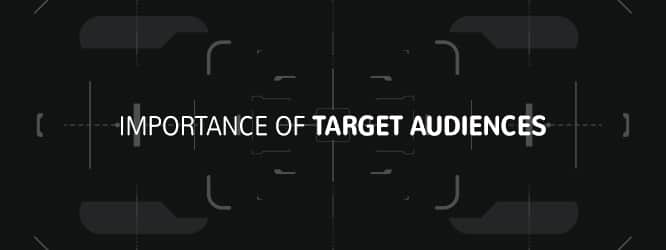
Establishing a target audience is a critical step in making sure the correct tone and messaging techniques are being used during your campaigns.
The primary reason for target audience research is that not all products can be consumed or offered to all customers. That is, every product or service has its own ideal market demographic, and not chasing the right audience segment can have negative effects on your bottom line.
Understanding how to find your target market is key to informing and supercharging your campaigns.
Target Audience Definition?
Your “target audience” is the overall audience you want to sell to or reach, otherwise known as your target market— it’s that simple.
Your target audience may include a specific group of demographics, such as men in their 20s, parents or grandparents; location, such as people who live in NYC; or consume behavior and interests, such as dog owners or sports lovers. Every target audience has specific interests and may engage differently with your campaigns. For some marketing campaigns, you want to get as granular as targeting males in their 20s who have dogs and make over $30,000 a year.
Learn How to Activate Your Target Audience
How Does Audience Targeting Work?
Audience targeting involves collecting and analyzing consumer data to establish the ideal customer for your product or service. You can use this information to determine buyer personas that inform your decision-making and help you create effective personalized marketing campaigns.
Successful audience segmentation and targeting allows you to create content that resonates with the right people, engages their interest in what you have to offer and ultimately inspires them to become paying customers.
Audience targeting involves breaking down consumers into specific segments based on the data you’ve collected about them and their behavior, such as their interests, demographics and buying history. Then, you’ll use that information to tailor your marketing messages directly to that segment for more powerful engagement and, ideally, greater conversions.
Why Is Having a Target Audience Important?
So why do you need to concern yourself with these classifications?
Consider this. You have put in the long hours and finally finished making that killer product or service. You think your work is done, but no — it is only beginning. Now, you need to introduce people to the work you have spent so much time on. You need to show them why your product, publication, or service is so unique and why they should choose you over your competitors. You probably already have some idea of who you want to reach, your ultimate customer. In the same way, you agree on or work with achievable business goals, it is essential to set a target-able, reachable audience. You must choose who the primary consumer or customer is for your product — otherwise, you won’t be able to measure success, let alone obtain it.
Learn How to Activate Your Target Audience
By finding that target audience, you can tailor or craft messages that appeal specifically to that group, to ensure that it is striking a chord with them, and ultimately gain their attention.

Once you know who you are targeting, it is also that much easier to make decisions on media allocations. If you are specifically targeting women in their 20s, you don’t need to place an ad on EVERY site. You can choose to advertise only in those that resonate with the specific audience. By doing this, you will save money, get a better ROI (return on investment) and reduce wasted audience.
Can I Target More Than One Audience?
Sometimes, it’s necessary to consider the number of audiences you’re targeting. It’s not always as simple as a one-size-fits-all approach. Your target audience can be several — dozens or even hundreds — of groups of people, who have different goals, needs, characteristics and points of view.
People tend to claim that, “Any business is good business.” But, is it? Are you losing money in messaging campaigns because you’re following this idea?
Generalizing your campaign or trying to appeal to a much larger group — also defined as the mainstream masses —will likely turn out to be a big mistake when it comes to marketing. That is because marketing tends to be a very specific, creative and focused process. Once you know who your target audience really is, you’ll be able to hone in on and convey a stronger, more direct message, which will ultimately lead to more conversions for your company and an impressive ROI.
Learn How to Activate Your Target Audience

It’s also important to clarify that it’s okay to come up with separate marketing campaigns for each segment or target audience. In fact, it’s downright necessary when you’re working with multiple groups or segments. You don’t want to build a generalize strategy or campaign that isn’t effective with either group, because then you’re just wasting resources.
How to Define a Target Audience
- Consult Your Business Plan
- Research Your Customers
- Find Your Target Audience
- Build Your Target Audience
So, how do you define your target audience? How do you find the true “perfect” customer for your product or service? Better yet, how do you know your campaign is going to resonate with that group or demographic?
Let’s start with the basics. Ask yourself this: who is the audience at the receiving end of your marketing efforts?
As much as your product or service may appeal to a large group of people, it doesn’t make sense to market to everyone. You obviously want as many people to know about your business as possible, but the more potential customers you want to reach, the more time, effort, and money it is going to cost to do so.
Learn How to Activate Your Target Audience
Depending on your brand or the objectives of the campaign, specific audiences may hold a higher value to you. Targeting high-value groups for your business and customizing messaging to reach particular audiences leads to a higher ROI. Rather than digging through a haystack in hopes of finding a needle, you can adjust your campaign messaging to be like a magnet that brings the needle, your target audience, to you.
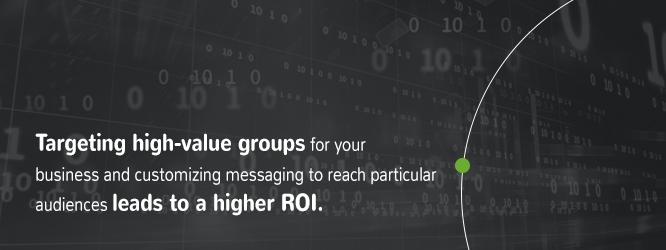
Even today, marketing digitally without knowing how to find your target audience can waste time and energy, which can affect your bottom line significantly. A target audience is an audience that, when you reach them, are more likely to convert to sales because their purchasing interests coincide with what you’re selling.
By selecting different target audiences, and focusing on the portion of the people who would be most interested in your products or services, you are allowing yourself to communicate and engage with that segment more personally.
Follow this step-by-step process to identify your target audience, based on where you are now, and where you want to be in future campaigns.
1. Consult Your Business Plan
When you are identifying your target audience, it is important also to determine the features of your product or service. Ask yourself these important questions:
- What needs does your product or service fulfill for a potential customer?
- How does your product or service differ from other products or services in your industry?
- Is your product more affordable?
- Is it more effective?
You must take many of these things into account before figuring out who will be on the receiving end of your marketing efforts. Think about who might be interested and who may benefit from having access to what you offer. These are the people that will make up your target audience.
Keep in mind when thinking about how to market to your target audience that today’s consumers don’t like to be “sold to.” They are much savvier than consumers of the past. Between television and CTV advertising, print ads and all the various forms of advertising on the internet, they’ve seen it all. They want to be informed and entertained. They want to be in control of their buying experience. By learning how to identify your target audience and marketing to that group, you are giving them that control.
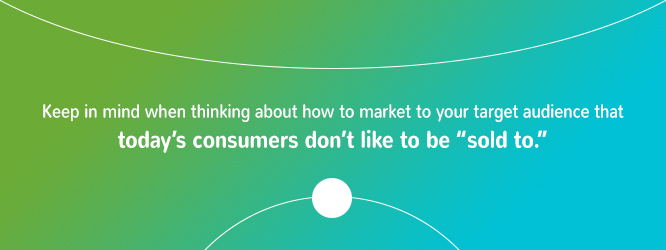
If you are already in business, defining your target audience can be as easy as looking at your best customers. Who are they, and what traits do they have in common? Do you have more success selling to a particular demographic? Who do you want to get in front of, and what do you already know about this group of people?
2. Research Your Customers
Regardless of marketing, you must know your competitors well to make an impact in your current market. But to find your target audience, and what they want, you’ll also need to better understand the competition. Pull together relevant information about your industry, the market, your competition, and most importantly, the broad potential customer you have identified. How have your competitors marketed their products/services, and to whom?
Another source for finding your target audience is your existing or best customers. If you want to find more of these people (and grow your customer base), find out what makes them tick. What interests them? How did they find out about your product/service? What did they like or dislike about it? The more information you have, the easier it is to identify and reach your target audience.
If you already have access to a data enrichment solution, you should consult the audience analytics you have available to learn even more. For example, Lotame’s Audience Analytics tools can give additional insights into your target audience’s behaviors, interests, actions, and demographics across screens. All of this information should be combined as you build your target audience for a holistic view and understanding of the consumer. You’re essentially creating a comprehensive or nearly complete profile of the kind of customer you’re targeting.
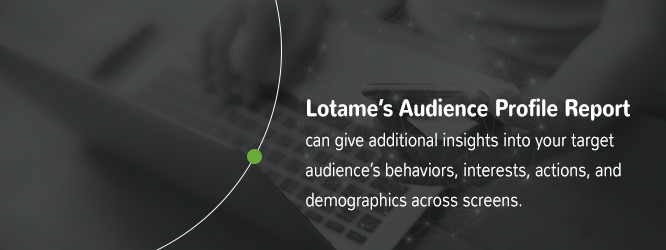
3. Find Your Target Audience
As you might expect, it helps to identify and understand the broader market you’re after, before narrowing it down to specifics. The process is as follows:
- Look at existing marketing strategies.
- Identify existing customer groups or segments.
- Review your competition and other businesses in the market.
- Know your product and services, as well as how they contribute to consumers.
- Consider the overall market you are accommodating.
- Analyze any data and information you have, especially performance details.
- Use everything you’ve collected thus far to discern your true or ideal target audience.
You could skip right to defining your target audience, but there’s a chance you’ll make a mistake and focus on the wrong customers. That’s why it’s always a good idea to discover your market first, then move on to your target audience.
As an incredibly basic example, let’s say you’re looking to target one group only. Right away — without considering your market — you could narrow things down using specifics you already know, such as males who enjoy football. Naturally, you get right to creating and managing a variety of marketing campaigns and promotions tailored to this audience.
Successful or not, this is a problematic approach. Why? Because really, you should be focused on a much broader group, like males who enjoy sports as opposed to a single activity. Unless you already have collected the necessary data, you don’t know whether you’re missing out on other audiences or customers just because you narrowed down your focus too quickly.
Males who enjoy basketball, soccer or even golf may also be interested in your product or service, but you ignored them by closing in on only the football group. Specifics are necessary as the last step, yes, but you want to be as accurate as possible when choosing your focus, which includes looking at a broader audience to start.
4. Build Your Target Audience
Who are your “buyer personas,” or ideal customers? You need to get right to the nitty-gritty of your typical or perfect person. The more granular you can get with the information, the better. Look at traits such as:
- Demographics: This information can include anything from age to gender, geography, to marital status.
- Psychographics: This information goes beyond the demographics and identifies more about a customer’s psychology, interests, values, attitudes, behaviors, and much more.
- Technographic: This information relates to the devices. Software and other “technical” attributes of your audience.
All types of information are essential in developing your customer profile(s). The demographic information will help in identifying the kind of person who will potentially buy your products and services. The psychographic information takes it a bit further and helps you to understand the reasoning behind why the customer may make the purchase. Lastly, the technographic piece helps you learn where to reach your different audiences and on what device.
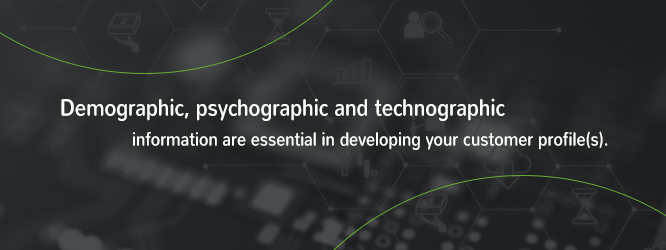
Speaking of where your audience spends their time online, it is essential to find out where they hang out. What websites do they visit? Which social networks are they spending most of their time on? Do they prefer email over other forms of communication?
This helps you create the right message, and place that message in the right setting. Chances are, if your audience is not checking their email a lot, they won’t see your email campaign. The information you put together for your customer profile, combined with knowing where your audience hangs out online will improve the delivery effectiveness of your message.
Consider giving your buyer personas actual names. This will help you further distinguish them and inform your marketing plan as you create it. If you think of these personas as real people rather than a collection of traits, you will have an easier time understanding whether or not people like your buyer persona are a part of your target audience and exactly how you will target your marketing to them.
Target Audience Examples
Explore the following examples of target markets:
- Baseball training facility: This business’s target audience is males, ages 12 to 25, in Central Pennsylvania. They are likely enrolled in school and value consistent scheduling and high-intensity training sessions. They spend a lot of time on their mobile devices and are highly engaged on Instagram and TikTok. They use social media to find new training opportunities and want to interact with informative posts that offer tips to improve their performance.
- Medical spa: This brand’s target market is males and females ages 35 to 65. They earn upwards of $85,000 a year and live in the New York Metropolitan Area. This audience values self-care and appearances. Among their greatest challenges is finding affordable, high-quality anti-aging procedures in their region, and they use Instagram to discover and assess med spa services.
Want more audience targeting strategies? Check out these vertical specific audience targeting tips for CPG brands, Auto brands, or travel brands.
Where Do I Find This Information on My Customers?
If you have access to a data collaboration platform, or DCP, and have already begun running marketing campaigns, you should already have a lot of information about the people who are interacting with those campaigns. By tagging your campaign creative, you can build an audience of “clickers” or “converters” (or both!) and look at the audience profile reports of both of these groups.
The DCP will provide demographic, behavioral and interest data about each group, and will also provide you with the option to reach more of these audiences via lookalike modeling. If you’re not sure where to start with targeting, using these “seed audiences” as a jumping-off point could be a simple idea. Test it out and see how the performance goes compared with a non-targeted campaign.
Are All Target Audiences Created Equal?
Should you focus on all potential target audiences, or only a few? Are they all equal in regard to value and ROI? No, absolutely not, because some just won’t have the impact or influence on your business that others will.
Therein lies the problem with chasing a niche or specific group. Sometimes, it’s possible to get so precise that the overall impact of a group is minimal at best. Before actually honing in on a particular audience, you want to make sure the investment is worth it for your business and team.
The best way to understand the value of your target audiences is to compare them on an even playing field. At this point, you’ve already done a majority of the work and research and know which segments are ideal for your product. Now, it’s time to consider how those groups will impact your bottom line. If you’re pouring a ton of resources into targeting a specific audience, yet you see no adoption or return, it’s nothing more than a waste.
So, how do you understand performance or potential, before actually marketing to said audiences? The answer is analytics or predictive tools. During your research, you should have also come across similar data that reveals what your customers are interested in, as well as the kinds of things they resonate with. This will provide you with a more informed approach — you’ll know before entering the market whether your product is going to succeed or fail. No, you may not know the total impact, influence or revenue before taking action, but you will have some idea of how you’re going to fare, and that’s just as important.

Lotame’s next-generation data platform, Spherical, gives marketers the ability to gather this kind of information and analyze first-party customer data.
How Often Do I Need to Define My Target Audience?
Once you begin marketing to your target audience, you may feel that your work is essentially done in this regard. Unfortunately, the task doesn’t end after you launch your campaign and send out waves of advertising.
It is essential that you monitor the campaign performance to keep it competitive. How are people reacting to your ads? Are they clicking? Are they converting? You need to adjust your strategy if your marketing isn’t practical for your target audience. Or, perhaps the people you thought were your ideal customers aren’t the ones you should be trying to reach?
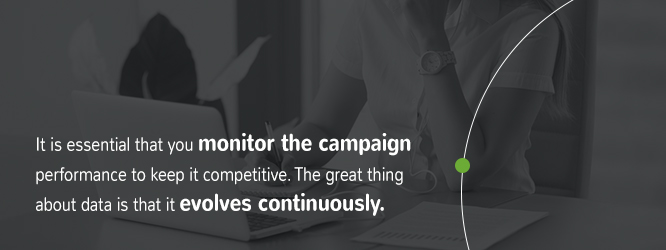
The great thing about data is that it evolves continuously. As time passes, you can bootstrap your data to make your audience targeting more precise. The information you collect now will give you a good starting point for how to identify your target audience and find the best ways to market to them. Once they start responding, you will have even more information you can use to break down your customers’ needs and desires further. When you see this process in action, it can be extremely exciting — especially when you see the effect good data management has on your company’s bottom line.
Before you start your marketing, you need to make sure you know how to track sales, interactions, requests for information and more. This way, you can stay ahead of the game, especially with your messaging and advertising environment.
As your business matures, keep following these steps. Your target audience may change as your business grows, and finding your target audience should be a continual effort. Regardless of where your business is, identifying your target audiences can push you one step closer to maximizing your ROI and reaching your overall business goals.
Ways To Reach Your Target Audience
Explore the following tactics for how to reach your target audience:
Search Engine Optimization and Relevant Content
Today’s consumers rely on search engines for a wide range of purposes, including:
- Finding answers to important questions.
- Discovering new products and services.
- Learning more about products before making a purchase.
- Locating nearby businesses.
Harnessing the power of search engine optimization (SEO) is an effective way to increase visibility and discoverability among your target market.
SEO works by strategically implementing certain industry keywords and relevant content into your web pages so they appear at the top of search engine results, making it easier for consumers to find them.
As you boost your search engine rankings, you can improve the odds of people in your target market becoming paying customers by getting in front of users who are actively seeking out your products or services. Your SEO strategy will involve uncovering the specific topics and keywords that your audience cares about.
For a target audience example, a hair care brand might develop online content about remedying split ends and preventing hair breakage. When a consumer looks up ways to correct their split ends on Google, the brand’s blog post will appear in search results. While the consumer is on the brand’s site, they may learn more about the company’s restorative hair serum and consider buying it to solve their problem.
Had that business not used SEO best practices to become highly visible on search engine results, the customer may never have discovered their products.
Paid Advertising
Paid advertising is another great way to improve sales by increasing visibility among your target market. Brands can pay for ad space on websites, social media pages and search engines to promote their products or services to users.
One of the greatest benefits of paid advertising is having greater control, thanks to the metrics and analytics that are available to you, such as:
- Cost-per-click: A metric encompassing how much a brand pays for the advertisements on a web page based on the number of users that click on the ad.
- Impressions: The number of times an ad is shown to potential customers.
- Site traffic: The measure of how many web users visit a specific website from a paid ad.
- Bounce rate: The number of people who visited a website and exited without interacting with any of the site’s elements.
- Conversions: Users who took a desired action based on a brand’s paid ad.
- Cost-per-conversion: A metric for the amount of money a brand spends to acquire a new customer and make a sale from paid advertising.
You can use this information to inform future campaigns and create more precise and effective advertising materials that entice your specific target audience.
Contextual Advertising with Programmatic Curation
Another way you can use paid advertising for audience targeting is by tapping into programmatic curation, a relatively new way of buying media. Curation allows media buyers or advertisers to directly access supply-side inventory, using programmatic technology to streamline the buying and selling of ads. This tool makes the ad buying and selling process more efficient for both advertisers and publishers. Through curation, brands, retailers, publishers, and data providers can combine their own data with third-party inventory in Private Marketplaces (PMPs) and then deliver it to Demand-Side Platforms (DSPs) as easy-to-activate Deal IDs
Social Media
Your business can also use social media marketing to connect with its target market and harness greater engagement. You do not need to be active on all social channels — the key is using the platforms where your social media target audience is most engaged.
One of the best ways to increase your reach is by crafting relevant, high-quality content that your followers will interact with and share with other users. Strategic and interesting content can help boost brand awareness and increase your organic growth. Businesses can also use paid advertisements on social media platforms to supercharge their marketing efforts and reach more of their target customer audience.
Utilizing hashtags is an easy way to get your posts in front of more of your target market. Using relevant and specific tags helps users easily discover your content when they look up those keywords.
A huge perk of working with social media is having access to valuable audience insights and analytics about your target market. You can use the data from these platforms to measure the success of your digital marketing campaigns and determine what strategies work well for your business in terms of conversion and engagement.
Influencer Marketing and Branding
Influencer marketing is an incredibly powerful tool your business can use to connect with your target audience.
The industry’s market value more than doubled from 2019 to 2022, and it is one of the most popular and compelling types of online marketing available to businesses. Today’s consumers are more likely to trust recommendations from their favorite influencers than celebrity endorsements.
The key to optimizing this type of marketing is working with influencers that your target audience already respects and trusts. The content they create should be relevant to your industry and market.
For instance, having an influencer who works within the beauty and makeup industry promote your tire brand may not make sense or offer very good conversions for your business. Instead, you’ll want to choose someone whose branding aligns with your own and can speak to the quality and effectiveness of your products or services.
There are a few different ways that brands can work with influencers, including:
- Brand ambassadors: Your business can appoint brand ambassadors who embody your brand identity and can help increase awareness and sales.
- Sponsored posts: You can pay influencers to share promotional sales content about your brand and its products or services.
- Brand collaboration: A collaboration involves working closely with an influencer to create a new campaign that is mutually beneficial for both parties.
Tools To Help Market to Your Target Audience
So, you’re ready to embark on your marketing journey. You’re armed with plenty of research, information, and data, and you know exactly who to target in your future campaigns — that’s great! It’s undoubtedly taken a lot of work to reach this point, as well as a lot of resources. You’ll want to make sure all that work wasn’t for nothing, though, which means finding a viable tool to help you achieve your goals. What target audience software will make a difference for you?
That’s where customer data solutions like a Data Collaboration Platform, come into play. Once you have the necessary data, it’s all about putting it to work. Data collaboration platforms, or DCPs are the backbones of data-driven marketing campaigns and provide a central, unified dashboard to work with audience data. They can do things like onboard, connect, enrich and activate audience data from any source, including third-party, second-party, first-party, online, offline or even mobile users. Lotame’s end-to-end data collaboration platform, Spherical, accelerates customer data – whether you have it or need it.
Get Data Empowered With Lotame’s Spherical Platform
Having the correct data and managing it efficiently will lead to a better ROI through targeted campaigns. Using data-driven strategies brings you closer to hitting your business objectives, and an established data management system can help you manage and optimize your data.
With Lotame’s Spherical platform, marketers and media companies can access global, high-quality addressable custom audiences from the world’s largest data marketplace. By using these highly targeted audiences, companies can execute true people-based marketing across browsers, devices, and platforms, including CTV.
Contact Lotame to get Data Empowered today!


